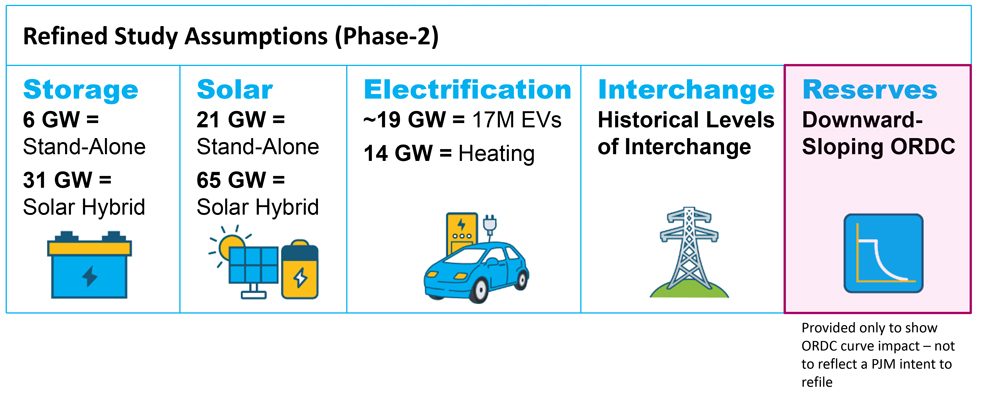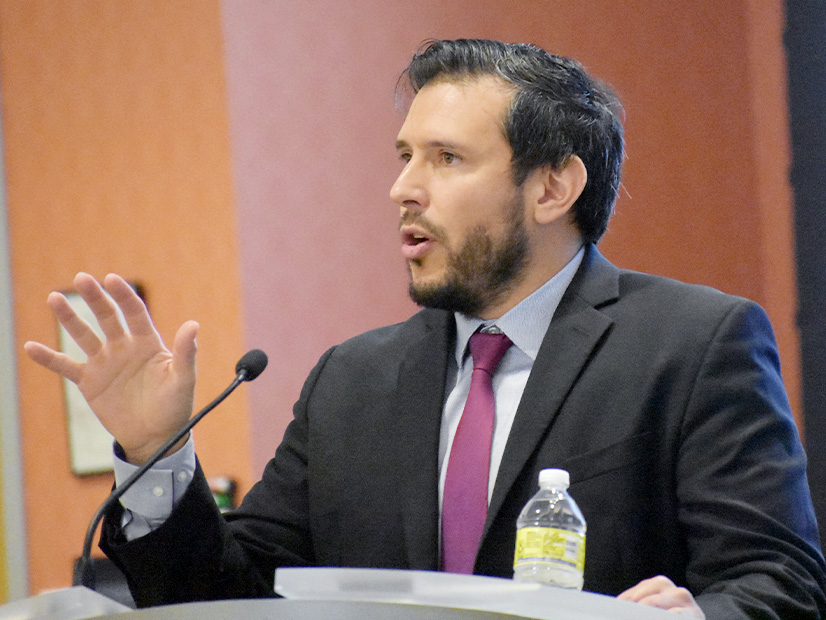VALLEY FORGE, Pa. — PJM highlighted the release of the second phase of its multiyear study to examine the grid’s transition to more renewable energy during last week’s Annual Meeting of Members.
Emanuel Bernabeu, senior director in PJM’s applied innovation and analytics department, presented the report, “Energy Transition in PJM: Emerging Characteristics of a Decarbonizing Grid.” The report expands on the paper released by the RTO in December. (See PJM Energy Transition Study Released.)
Bernabeu said PJM wanted the studies to specifically look at the impacts on the RTO’s grid while also examining comparisons to other territories.
“Even though we’re in the same business, it’s amazing how different the system behaves,” Bernabeu said. “We’re not California; we’re not Texas. And it’s important to translate what it means for us.”
The results of Phase 2 suggested several areas for PJM and its stakeholders to focus on.
 Study assumptions in Phase 2 of PJM’s energy transition study | PJM
Study assumptions in Phase 2 of PJM’s energy transition study | PJM
Bernabeu said it revealed that electrification will shift the seasonal resource adequacy risk from summer to winter. Traditionally resource adequacy risk in PJM has been concentrated in the summer season; in an accelerated transition scenario in the study, 95% of the load-loss risk is experienced in the summer and the remaining 5% in winter.
But electrification has an “asymmetrical impact,” Bernabeu said, with demand growth in winter of 15% more than doubling summer totals of 7%, driven by winter heating. The switch creates a “pronounced shift in both the seasonal and hourly risk profiles,” including a new seasonal split of load-loss risk of 20% in summer and 80% in winter.
Bernabeu said about 60% of the load-loss risk in winter is concentrated during the last four hours of the day, creating a “slightly higher, but substantially wider,” peak demand compared to summer.
Another focus area of the study indicated market changes are needed to incentivize flexibility and “mitigate uncertainty,” Bernabeu said, to accurately reflect the flexibility needs on the system. He said the current reserve market construct uses a two-step operating reserve demand curve (ORDC), which “fails to capture the uncertainty” of the rising number of renewable resources.
Study simulation results found the two-step ORDC procures less than one-third of needed reserves on the system, and with an average clearing price of 2 cents/MWh, it also “fails to send long-term market signals to incentivize flexibility,” Bernabeu said.
The integration of renewable resources is also increasing the need for balancing resources to meet forecasted ramping requirements. In the accelerated scenario of the study, the driver for the ramping requirements is split, with 50% coming from existing load ramping and 50% from the variability of renewable resources.
Simulation results showed a “drastic increase” in the net-load ramping requirement, Bernabeu said, with a 90th percentile slope of 10 GW/hour and a maximum slope exceeding 20 GW/hour, calling it a “very severe run today.” He said on certain extreme days, the total climb from the beginning to the end of the ramping period was 73 GW, which is more than peak summer loads in NYISO and ISO-NE combined.
Thermal resources performed a “critical role in maintaining reliability” in the study, Bernabeu said, supplying 50% of the ramping needs, with 42% coming from gas generation and 8% from coal. Hydro resources, including pumped-hydro storage, delivered up to 15% of the ramping needs.
The study also looked at how energy storage enhances flexibility; at the same time, seasonal capacity and energy constraints will require transmission expansion, long-term storage and other emerging technologies for reliability. Renewable integration scenarios included up to 6 GW of standalone storage and 30 GW of storage connected to 35 GW of solar hybrid resources.
Storage had a “profound impact” in the ancillary services market, Bernabeu said, providing up to 80% of synchronous reserves. But transmission congestion patterns changed “drastically,” he said, with overall congestion increasing by 60%.
“As you increase the penetration of renewables, you are going to need a broader set of solutions,” Bernabeu said.
The next phase of the study will include more sensitivities, including the growing number of coal and gas generation retirements, and federal and state renewable energy policies.
“We’re not proposing solutions here,” Bernabeu said. “All we want to do is to share the conversation, identify gaps and opportunities, and potentially highlight what things may need to change.”


